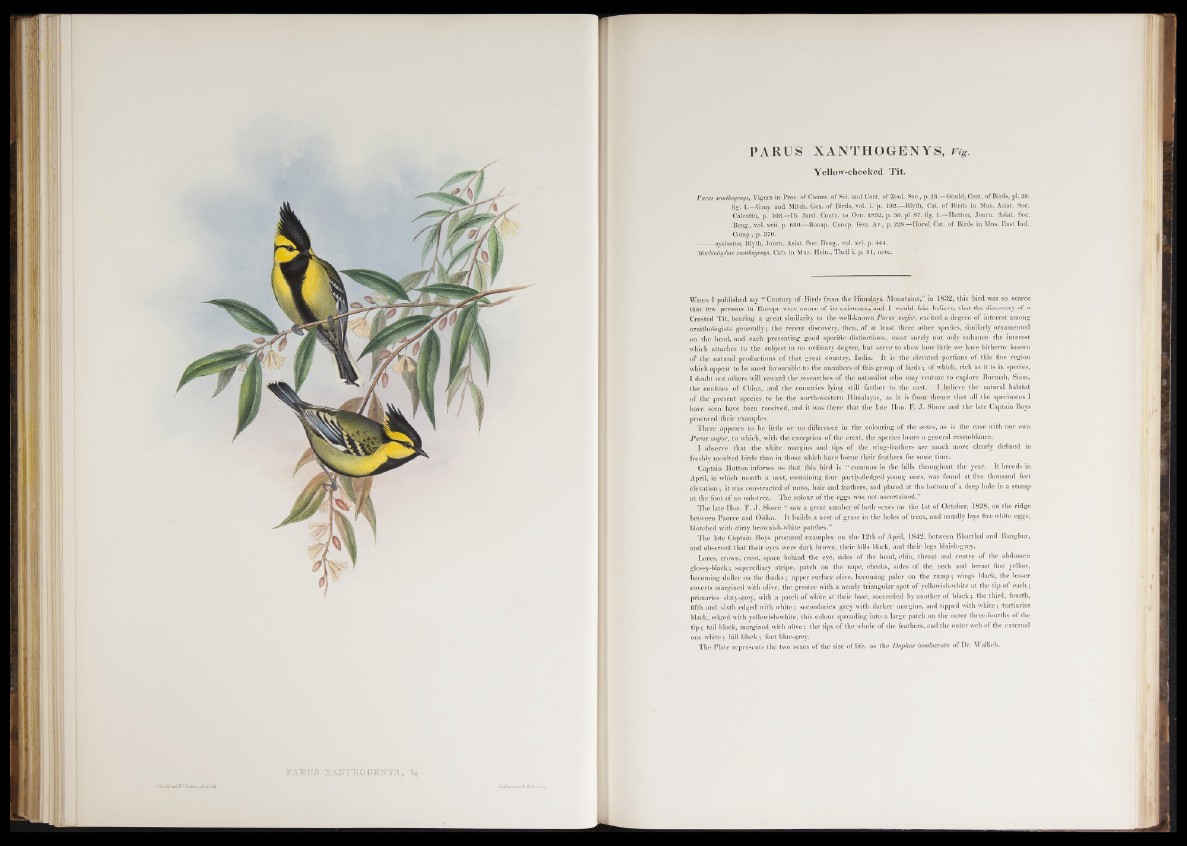
PA R ITY X A N T H © © F /N Y S 9 Jig.
P A R U S X A N T H O G E N Y S , v * .
Yellow-cheeked Tit.
Par us xanthogenys, Vigors in Proc. of Comm, of Sci. and Corr. of Zool. Soc., p. 23.—Gould, Cent, of Birds, pi. 29.
fig. i.—Gray and Mitch. Gen. of Birds, vol. i. p. 192.—Blyth, Cat. of Birds in Mus. Asiat. Soc.
Calcutta, p. 103—lb. Jard. Contr. to Om. 1852, p. 50.pi. 87. fig. 1.—Hutton, Joum. Asiat. Soc.
Beng., vol. xvii. p 690.—Bonap. Consp. Gen. Av., p. 228.—Horsf. Cat. of Birds in Mus. East Ind.
Comp., p. 370.
— apolontus, Blyth, Joum. Asiat. Soc. Beng., vol. xvi. p. 444.
Machlolophus xanthogenys, Cab. in Mus. Hein., Theil i- p. 91, note.
W h en I published my “ C entury of Birds from the Himalaya Mountains,” in 1 8 3 2 , this bird was so scarce
that few persons in Europe were aware of its existence, and I would fain believe, tbat the discovery of a
Crested Tit, bearing a great similarity to the well-known Parus major, excited a degree of interest among
ornithologists generally; the recent discovery, then, of a t least three other species, similarly ornamented
on the head, and each presenting good specific distinctions, must surely not only enhance the interest
which attaches to the subject in no ordinary degree, but serve to show how little we have hitherto known
of the natural productions of that great country, India. It is the elevated portions of this fine region
which appear to be most favourable to the members of this group o f b ird s; of which, rich as it is in species,
I doubt not others will reward the researches o f the naturalist who may venture to explore Burmah, Siam,
the confines of China, and the countries lying still farther to the east. I believe the natural habitat
of the present species to be the north-western Himalayas, as it is from thence that all the specimens I
have seen have been received, and it was there that the late Hon. F. J . Shore and the late Captain Boys
procured their examples.
There appears to be little or no difference in the colouring o f the sexes, as is the case with our own
Pains major, to which, with the exception of the crest, the species bears a general resemblance.
I observe that the white margins and tips of the wing-feathers are much more clearly defined in
freshly moulted birds than in those which have borne their feathers for some time.
Captain Hutton informs us that this bird is “ common in the hills throughout the year. I t breeds in
April, in which month a nest, containing four partly-fledged young ones, was found a t five thousand feet
elevation; it was constructed of moss, hair and feathers, and placed at the bottom of a deep hole in a stump
a t the foot of an oak-tree. The colour of the eggs was not ascertained.”
The late Hon. F. J . Shore “ saw a great number of both sexes on the 1st of October, 1828, on the ridge
between Paoree and Oolka. I t builds a nest of grass in the holes of trees, and usually lays five white, eggs,
blotched with dirty brownish-white patches.”
The late Captain Boys procured examples on the 12th o f April, 1842, between Bhurthal and Ranghur,
and observed that their eyes were dark brown, their bills black, and their legs bluish-grey.
Lores, crown, crest, space behind the eye, sides of the head, chin, throat and centre of the abdomen
glossy-black; superciliai'y stripe, patch on the nape, cheeks, sides of the neck and breast fine yellow,
becoming duller on the flanks; upper surface olive, becoming paler on the rum p ; wings black, the lesser
coverts margined with olive, the greater with a nearly triangular spot of yellowish-white at the tip of each;
primaries slaty-grey, with a patch of white at their base, succeeded by another of b lack ; tbe third, fourth,
fifth and sixth edged with white; secondaries grey with darker margins, and tipped with white; tertiaries
black, edged with yellowish-white, this colour spreading into a large patch on the outer three-fourths of the
t ip ; tail black, margined witb olive; the tips of the whole o f the feathers, and the outer web of the external
one white; bill black; feet blue-grey.
The Plate represents the two sexes o f the size o f life, on the Daphne xnoolucrata of Dr. Wallich.